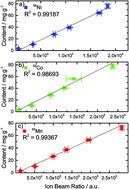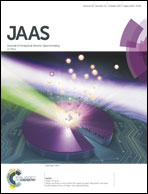Matrix-matched standards for the quantification of elemental lithium ion battery degradation products deposited on carbonaceous negative electrodes using pulsed-glow discharge-sector field-mass spectrometry
Abstract
In this work an external calibration approach for glow discharge-sector field-mass spectrometry (GD-SF-MS) using matrix-matched self-prepared carbonaceous standards for elemental battery degradation products of LiNi1/3Co1/3Mn1/3O2 (NCM111) positive electrodes like lithium, manganese, cobalt and nickel is adapted. Firstly, the standards were prepared using graphite mixed with increasing contents of NCM111 which was coated on a thin copper foil as a current collector. The homogeneous distribution of NCM111 in the standards was proven via SEM/EDX images and the bulk homogeneity of the electrode sheets was validated via ICP-OES. Afterwards, sufficient linearity could be obtained in a calibration range of 1 mg g−1 to 28 mg g−1 for 7Li with respect to the active material mass. Additionally, the matrix-matched relative sensitivity factors (RSFs) of each element could be calculated. Limits of detection (LODs) ranging from 80 μg g−1 (7Li) up to 393 μg g−1 (58Ni) could be achieved at low (R > 300) and medium (R > 4000) resolutions for the Element GD, respectively. Secondly, we adapted the matrix-matched RSF values in order to investigate cycled electrodes by monitoring the 7Li signal as well as common isotopes from lithium ion batteries – such as 31P and 19F, originating from the conducting salt – and transition metals to conduct depth-resolved analysis. The concentration of transition metals in all of the cycled electrodes was below the LOD of the GD-SF-MS method which was investigated in a previous study, showing a maximum bulk deposition of transition metals of 4.5 mg g−1. As expected, an accumulation of 7Li in the first few minutes (=surface layers) of sputtering was observed in the cycled carbonaceous negative electrodes followed by a decreasing 7Li signal with ongoing sputtering indicating the presence of a solid electrolyte interphase (SEI) passivation layer.



 Please wait while we load your content...
Please wait while we load your content...